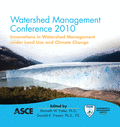Interannual-to-Daily Multiscale Stream Flow Models with Climatic Effects to Simulate Surface Water Supply Availability
Publication: Watershed Management 2010: Innovations in Watershed Management under Land Use and Climate Change
Abstract
Water utilities that rely on surface water supplies often experience variable production due to weather. Future drinking water supply for such systems is mathematically uncertain. However, system simulations using flow data can determine the probability of sufficient future supply in support of planning and management activities, such as evaluating expansion alternatives and developing water shortage plans. In the most direct form of these applications, historical source stream flows can be applied to operational models of system and policy alternatives, showing how those alternatives would have fared under historical hydrologic conditions. In many cases, however, the available historical data are insufficient to capture likely upcoming hydrologic conditions and their impacts on system and policy performance. Historical stream flow records are often too short to capture potential source variation in sufficient detail and/or may not reflect future hydrology due to climate oscillations or change. Resulting evaluations of system or policy alternatives may not adequately reflect true future performance and reliability. One remedy for addressing these historical data shortcomings is to construct statistical models of source stream flows that reflect longer-term climatic mechanisms, and then use stream flow simulations from those models in the place of historical source flow data when evaluating system and policy alternatives. Statistical models can be used simulate long stream flow series or generate multiple series depicting a range of possible flow outcomes, producing long-term and/or probabilistic characterizations of system and policy alternatives. When developing statistical models for these applications, special attention must be directed toward the time scales at which source flow variability impacts system performance and reliability. Surface water supply reliability is often impacted by hydrologic variability at multiple time scales, from instantaneous to inter-annual, depending on storage volumes, time bases of withdrawal permits and operations, and other factors. The time scales which are relevant to reliability can vary from system to system. During source flow model development, it is therefore important to understand the time scales of relevance to system reliability for the specific application, and then ensure that flow models engender flow statistics at those time scales that are plausible. For example, a surface water supply that depends on an inline reservoir with a residence time of 15 days would require a stream inflow model that represented daily- or weekly-scale source flow distributions and autocorrelations well. It may also be important for the source flow simulations to reflect longer-term variations, such as ENSO modality or systematic climate change, but any such simulations that did not also properly reflect daily statistics properly would not accurately depict critical short-term reliability issues among system alternatives. On the other hand, daily- or weekly-scale statistical fidelity may be less important if the reservoir had a residence time of, say, 150 days. To meet multi-scale modeling goals, it is often possible to develop and link multiple scale- specific models (or externally-generated simulation data) to produce final source flow simulations containing multiple-scale statistical fidelity. One such approach consists of sequential downscaling (Figure 1). Long-time-scale (e.g. interannual) models are used to engender longer-period hydrologic tendencies (e.g. ENSO, drought dynamics, climate change) in source flow or in rainfall that impacts source flow. Moderate-time-scale models are then developed to accept simulation inputs from long-time-scale models, producing moderate-scale (e.g. seasonal or monthly) simulations of source flow or rainfall that reflect moderate-scale statistics while respecting long-scale input conditions. If necessary, short-time-scale models are then developed to accept simulation inputs from moderate-time-scale models, producing short-scale (e.g. weekly or daily) simulations of source flow that reflect short-scale statistics while respecting long- and moderate-scale input conditions. This paper will describe a sequential downscaling procedure developed for Tampa Bay Water in Florida. Tampa Bay Water, along with Hazen and Sawyer, P.C., developed this procedure to support probabilistic analyses of its surface water supply system in a variety of projects.
Get full access to this article
View all available purchase options and get full access to this chapter.
Information & Authors
Information
Published In
Copyright
© 2010 American Society of Civil Engineers.
History
Published online: Apr 26, 2012
ASCE Technical Topics:
- Climates
- Design (by type)
- Engineering fundamentals
- Environmental engineering
- Flow (fluid dynamics)
- Flow simulation
- Fluid dynamics
- Fluid mechanics
- Hydrologic engineering
- Mathematics
- Models (by type)
- Multiscale methods
- Simulation models
- Statistics
- Streamflow
- Structural design
- Surface water
- System reliability
- Systems engineering
- Systems management
- Water (by type)
- Water and water resources
- Water management
Authors
Metrics & Citations
Metrics
Citations
Download citation
If you have the appropriate software installed, you can download article citation data to the citation manager of your choice. Simply select your manager software from the list below and click Download.
